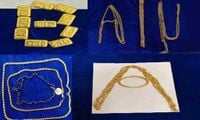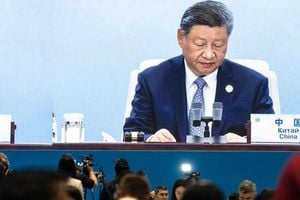In a sweeping crackdown on one of India’s largest gold export scams, the Central Bureau of Investigation (CBI) has launched an intensive probe into a complex racket that allegedly siphoned off hundreds of kilograms of gold and defrauded the government of more than Rs 1,000 crore annually. The investigation, which gained momentum after years of bureaucratic delays, centers on the misuse of the Duty-Free Import Authorisation (DFIA) scheme at Chennai Airport Cargo between 2020 and 2022.
The scam, first uncovered by the Directorate of Revenue Intelligence (DRI) in 2022, involved a web of jewel makers, customs officers, and logistics agents working together to exploit loopholes in the DFIA scheme. Under this scheme, jewelers are permitted to import gold bullion duty-free on the condition that they export an equivalent quantity of finished gold jewelry. However, officials allege the accused instead diverted the imported pure gold into the domestic market and exported counterfeit jewelry—often gold-plated brass or copper—to overseas destinations.
According to The New Indian Express, the CBI’s August 20, 2025, FIR names a total of 13 accused, including five customs officials, jewelry assessors, customs agents, and gold jewelry manufacturers. Those under the scanner include Customs Superintendents J Suresh Kumar, Alok Shukla, and P Thulasi Ram, appraiser N Samuel Deepak Avinash, customs agent A Mariappan, and jewelers Deepak Siroya (Siroya Jewellers), Santosh Kothari (Shree Kalyan Jewellery), Sunil Parmar (Sunil Jewellers), and Sunil Sharma (Shree Balaji Jewellers). All four jewelry shop owners are based in Chennai’s Sowcarpet area, a well-known hub for the gold trade.
The scale of the fraud is staggering. As DT Next reports, the accused imported 24-carat gold bars from abroad, which were supposed to be converted into 22-carat jewelry for re-export. Instead, they exported substandard ornaments, defrauding the Union Finance Ministry of over Rs 1,000 crore each year. The DRI’s investigation pegged the total amount of diverted gold at 2,170 kg—worth Rs 941 crore—while nearly 2,612 kg of gold-plated jewelry was exported fraudulently to Dubai and Malaysia during the two-year period.
The fraud came to light when Central Revenue Intelligence (CRI) officials detected discrepancies in the bills of lading for four consignments bound for Gulf countries. Detailed inspections revealed that the shipments contained fake and substandard jewelry, prompting the CRI to recommend a full-scale CBI probe. However, the case languished for nearly three years due to delays in obtaining sanction from state and central governments to prosecute government servants, as reported by The Times of India. Only recently did the CBI receive the necessary approvals, allowing them to formally register the case and begin their investigation in earnest.
On Saturday, August 30, 2025, CBI teams fanned out across Chennai, conducting searches at around 10 locations, including the Chennai Airport Customs Cargo Office, the residences of customs officials in Pallavaram, Alandur, Nanganallur, and Anna Nagar, as well as jewelry shops and manufacturers’ offices in Flower Bazaar, Sowcarpet, and Kondithope. According to DT Next, officials also examined the XRF Spectrometer used to test gold at the cargo complex and seized key documents for further analysis.
The CBI’s FIR, made public on the following Monday, sheds light on the elaborate methods used by the accused to perpetrate the scam. Customs officers allegedly certified fake jewelry as genuine, allowing it to pass through export channels without proper scrutiny. In return, they are believed to have received bribes totaling Rs 6 crore between November 2020 and January 2022. For every gram of fake jewelry exported, the officers reportedly received a bribe of Rs 50, which was delivered directly to their cars.
Investigators also uncovered evidence of undeclared immovable properties and illegal possession of 1,675 grams of 24-carat gold chains at the residence of Superintendent Suresh Kumar. According to the CBI, phone records indicated his involvement in assisting ‘courier’ passengers involved in smuggling during his airport shift duty. The investigation further revealed that some officers worked as jewelry examiners even when they were not officially rostered by the department, suggesting a deep-rooted conspiracy.
The cash generated from the sale of diverted gold bullion was sent to Dubai through hawala channels, a clandestine method of transferring money outside the formal banking system. Meanwhile, the gold jewelry manufactured in Rajkot, Kolkata, and Chennai—containing only about 10% gold—was declared as 22-carat and exported, with the gold coating designed to fool the spectrophotometer readings during customs checks.
Customs officials allege that the jewelers hatched the plan to obtain gold bullion from designated agencies such as HDFC Bank and the public sector unit MMTC, only to sell it in the black market to three jewelers in Chennai. The proceeds, once laundered through hawala, made their way to Dubai, further complicating the money trail for investigators.
As The Times of India notes, the customs officers and appraisers responsible for processing the shipping bills of the four jewelers certified the fake jewelry as genuine, thereby enabling the fraudulent exports and undue financial gain. The customs broker Mariappan, who acted as the customs house agent in all the cases, has also been named as an accused in the FIR.
The CBI has charged the accused under sections for corruption, criminal conspiracy, and cheating. Officials say more individuals may be added to the case as the investigation progresses, and arrests are likely in the coming weeks.
The scale and sophistication of the scam have raised serious questions about oversight and accountability within India’s customs and export control systems. The use of advanced testing equipment, such as the XRF Spectrometer, was circumvented by the simple expedient of gold-plating base metal ornaments to match the declared purity on shipping documents. This, combined with systemic corruption and collusion at multiple levels, allowed the syndicate to operate with impunity for years.
For many in Chennai’s jewelry trade, the scandal has cast a long shadow. While the DFIA scheme was intended to boost exports and support legitimate businesses, its misuse has now triggered a far-reaching probe that could reshape the regulatory landscape for years to come. The CBI’s ongoing investigation is expected to unearth further details in the coming months, potentially leading to reforms aimed at plugging loopholes and strengthening oversight over precious metal imports and exports.
As the probe widens and more evidence comes to light, the gold export scam at Chennai Airport stands as a stark reminder of the vulnerabilities inherent in complex trade schemes—and the high cost of lax enforcement.




